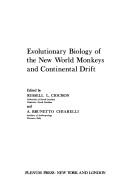| Listing 1 - 10 of 11 | << page >> |
Sort by
|

ISBN: 0226327884 9780226327884 Year: 1977 Publisher: Chicago, Ill. University of Chicago Press
Abstract | Keywords | Export | Availability | Bookmark
 Loading...
Loading...Choose an application
- Reference Manager
- EndNote
- RefWorks (Direct export to RefWorks)
Book
ISBN: 9781139034210 9780521881586 9781107341319 1107341310 1139034219 9781107345065 1107345065 9781107347564 1107347564 0521881587 1107357187 1107233704 110734381X 1107348714 Year: 2013 Publisher: Cambridge Cambridge University Press
Abstract | Keywords | Export | Availability | Bookmark
 Loading...
Loading...Choose an application
- Reference Manager
- EndNote
- RefWorks (Direct export to RefWorks)
The neotropical primate family Pitheciidae consists of four genera Cacajao (uacaris), Callicebus (titis), Chiropotes (bearded sakis) and Pithecia (sakis), whose 40+ species display a range of sizes, social organisations, ecologies and habitats. Few are well known and the future survival of many is threatened, yet pitheciines have been little studied. This book is the first to review the biology of this fascinating and diverse group in full. It includes fossil history, reviews of the biology of each genus and, among others, specific treatments of vocalisations and foraging ecology. These studies are integrated into considerations of current status and future conservation requirements on a country-by-country basis for each species. A state-of-the-art summary of current knowledge, Evolutionary Biology and Conservation of Titis, Sakis and Uacaris is a collective effort from all the major researchers currently working on these remarkable animals.
Pitheciidae. --- New World monkeys --- Primates
Book
ISBN: 0691143641 9780691143644 Year: 2020 Publisher: Princeton (N.J.): Princeton university press,
Abstract | Keywords | Export | Availability | Bookmark
 Loading...
Loading...Choose an application
- Reference Manager
- EndNote
- RefWorks (Direct export to RefWorks)
"This book is a broad synthesis of new world monkey evolution, integrating their unique evolutionary story into the bigger picture of primate evolution and Amazon biodiversity. Capsule For more than 30 million years, New World monkeys have inhabited the forests of South and Central America. Whether these primates originally came from Africa by rafting across the Atlantic or crossing overland from North America, they soon flourished. This book tells the story of these New World monkeys. Integrating data from fossil and living animals, it explores the evolution of the three major New World monkey lineages as well as how they fit into the broader story of primate evolution and Amazon biodiversity. After providing readers with necessary background in primate taxonomy and systematics, Rosenberger shows that the notion of adaptive zones is central to our understanding of primate evolution. The idea of adaptive zones can explain how radiations evolve, morphological adaptations appear, and communities form. From here, Rosenberger synthesizes what is known about New World monkeys' unique ecological adaptations, including those involving feeding and locomotion, as well as their social behaviour. The book's concluding chapters explore theories of how primates first arrived in South America and what their future looks like given the threat of extinction. Biography Internal Use Only Alfred L. Rosenberger is Professor Emeritus of Biological Anthropology at Brooklyn College. An expert on the origin and evolution of New World Monkeys, Rosenberger has contributed numerous articles in edited volumes and his work is published in journals such as Nature, Journal of Human Evolution and American Journal of Primatology . Audience The audience for this book is scholars and graduate students in biological/physical anthropolog and primatology, and to a lesser extent conservation biology, evolutionary biology, and behavioral ecology . Rationale - no copy text Other Relevant Info - no copy text"--
New World monkeys --- Primatology --- Primates
Book
ISBN: 0691081697 Year: 1976 Publisher: Princeton (N.J.): Princeton university press
Abstract | Keywords | Export | Availability | Bookmark
 Loading...
Loading...Choose an application
- Reference Manager
- EndNote
- RefWorks (Direct export to RefWorks)
New World monkeys --- Behavior --- Evolution
Book
ISBN: 069108338X 0691083371 0691613028 1400857163 9781400857166 0691640904 9780691083384 Year: 2014 Publisher: Princeton Princeton University Press
Abstract | Keywords | Export | Availability | Bookmark
 Loading...
Loading...Choose an application
- Reference Manager
- EndNote
- RefWorks (Direct export to RefWorks)
Launching a new series, Monographs in Behavior and Ecology, this work is an intensive study of five species of New World monkeys--all omnivores with a diet of fruit and small prey. Notwithstanding their common diet, they differ widely in group size, social system, ranging patterns, and degree of territoriality.Originally published in 1984.The Princeton Legacy Library uses the latest print-on-demand technology to again make available previously out-of-print books from the distinguished backlist of Princeton University Press. These editions preserve the original texts of these important books while presenting them in durable paperback and hardcover editions. The goal of the Princeton Legacy Library is to vastly increase access to the rich scholarly heritage found in the thousands of books published by Princeton University Press since its founding in 1905.
New World monkeys --- Ecology --- Platyrrhine monkeys --- Platyrrhines --- Platyrrhini --- Monkeys --- Primates --- New World monkeys - Ecology - Peru

ISBN: 0306404877 Year: 1980 Publisher: New York (N.Y.) : Plenum press,
Abstract | Keywords | Export | Availability | Bookmark
 Loading...
Loading...Choose an application
- Reference Manager
- EndNote
- RefWorks (Direct export to RefWorks)
Continental drift --- Monkeys --- New World monkeys --- New World monkeys, Fossil --- Paleobiogeography --- Anatomy --- Evolution
Book
ISBN: 0691081689 9780691081687 Year: 1976 Publisher: Princeton (N.J.): Princeton university press,
Abstract | Keywords | Export | Availability | Bookmark
 Loading...
Loading...Choose an application
- Reference Manager
- EndNote
- RefWorks (Direct export to RefWorks)
New World monkeys --- Behavior. --- Evolution. --- Mammals --- Callitrichidae --- Cebidae --- BEHAVIOR, ANIMAL
Book
ISBN: 0691644411 1400870445 9781400870448 9780691617268 9780691081687 9780691081694 0691617260 Year: 2015 Publisher: Princeton, NJ
Abstract | Keywords | Export | Availability | Bookmark
 Loading...
Loading...Choose an application
- Reference Manager
- EndNote
- RefWorks (Direct export to RefWorks)
The New World primates have radiated widely in tropical America, evolving a variety of adaptations to cope with different ways of life. This comparative survey examines many species. Some are highly specialized in unique ways; others have paralleled the lemurs of Madagascar or the monkeys and apes of Africa and Asia. The author's emphasis is on natural history, behavior, and ecology. Topics include geographical distributions, habitat preferences, territorial arrangements, activity rhythms, feeding techniques, defense mechanisms, and competition and cooperation among individuals of the same species. Much of the material is new, based on recent research in the field. Social reactions and organizations, and communication systems, are discussed in order to consider their implications for the evolution of primates in general and the development of languages and intelligence.Originally published in 1976.The Princeton Legacy Library uses the latest print-on-demand technology to again make available previously out-of-print books from the distinguished backlist of Princeton University Press. These editions preserve the original texts of these important books while presenting them in durable paperback and hardcover editions. The goal of the Princeton Legacy Library is to vastly increase access to the rich scholarly heritage found in the thousands of books published by Princeton University Press since its founding in 1905.
New World monkeys --- Cebidae --- Behavior, Animal --- Platyrrhini --- Behavior --- Haplorhini --- Behavior and Behavior Mechanisms --- Primates --- Psychiatry and Psychology --- Mammals --- Vertebrates --- Chordata --- Animals --- Eukaryota --- Organisms --- Zoology --- Health & Biological Sciences --- Chordates --- Chordate --- Eucarya --- Eukarya --- Eukaryotes --- Eukaryotas --- Eukaryote --- Animalia --- Animal --- Metazoa --- Mammalia --- Mammal --- Primate --- Behavior And Behavior Mechanism --- Anthropoids --- Anthropoidea --- Monkeys --- Monkey --- Acceptance Process --- Acceptance Processes --- Behaviors --- Process, Acceptance --- Processes, Acceptance --- Monkeys, New World --- Monkey, New World --- New World Monkey --- New World Monkeys --- World Monkey, New --- World Monkeys, New --- Autotomy Animal --- Animal Behavior --- Animal Behaviors --- Ethology --- Platyrrhina --- Platyrrhinas --- Platyrrhine monkeys --- Platyrrhines --- Vertebrate --- Evolution --- Psychiatry --- Psychiatrists --- Psychiatrist --- Behavior. --- Evolution.
Book
ISBN: 0387787046 1441926984 9786611875794 1281875791 0387787054 Year: 2008 Publisher: New York ; London : Springer,
Abstract | Keywords | Export | Availability | Bookmark
 Loading...
Loading...Choose an application
- Reference Manager
- EndNote
- RefWorks (Direct export to RefWorks)
South America is home to perhaps the largest and most diversified radiation (some 200 species) of nonhuman primates on Earth. Given the conservation imperative associated with forest destruction and environmental change, and recent increases in the number of primate field studies, the editors of this volume have brought together a distinguished set of primatologists, ecologists, evolutionary biologists, and conservation scientists to examine the nature and range of primate responses to changes in their ecological and social environments, and to use data on South American monkeys to develop models to address critical theoretical questions in the study of primate behavior, ecology, and conservation. Chapters in the volume focus on issues of taxonomy, biogeography and evolution, reproduction and fertility, mating systems, demography and life history traits, genetics and kinship, cognition, feeding adaptations, predation, rainforest ecology, the affects of forest fragmentation on ecosystem health and disease, the impact of human hunting on mammalian communities, and competing pressures for land use between the local human population and the remaining primate population.
New World monkeys. --- Primates --- Quadrumana --- Ecology --- Behavior --- Conservation --- Life sciences. --- Behavioral sciences. --- Ecology. --- Zoology. --- Life Sciences. --- Behavioral Sciences. --- Mammals --- Animal behavior. --- Animals --- Animals, Habits and behavior of --- Behavior, Animal --- Ethology --- Animal psychology --- Zoology --- Ethologists --- Psychology, Comparative --- Balance of nature --- Biology --- Bionomics --- Ecological processes --- Ecological science --- Ecological sciences --- Environment --- Environmental biology --- Oecology --- Environmental sciences --- Population biology --- Natural history --- Ecology .
Book
ISBN: 0852004079 9400973241 9400973225 9780852004074 Year: 1983 Publisher: Lancaster MTP Press
Abstract | Keywords | Export | Availability | Bookmark
 Loading...
Loading...Choose an application
- Reference Manager
- EndNote
- RefWorks (Direct export to RefWorks)
Animals, Laboratory --- Cebidae --- Primates --- Reproduction. --- Research. --- Laboratory Research --- Research Activities --- Research and Development --- Research Priorities --- Activities, Research --- Activity, Research --- Development and Research --- Priorities, Research --- Priority, Research --- Research Activity --- Research Priority --- Research, Laboratory --- Ethics, Research --- Human Reproductive Index --- Human Reproductive Indexes --- Reproductive Period --- Human Reproductive Indices --- Index, Human Reproductive --- Indexes, Human Reproductive --- Indices, Human Reproductive --- Period, Reproductive --- Periods, Reproductive --- Reproductive Index, Human --- Reproductive Indices, Human --- Reproductive Periods --- physiology. --- New World monkeys --- Reproduction --- Research --- Platyrrhine monkeys --- Platyrrhines --- Platyrrhini --- Monkeys --- physiology
| Listing 1 - 10 of 11 | << page >> |
Sort by
|

 Search
Search Feedback
Feedback About UniCat
About UniCat  Help
Help News
News